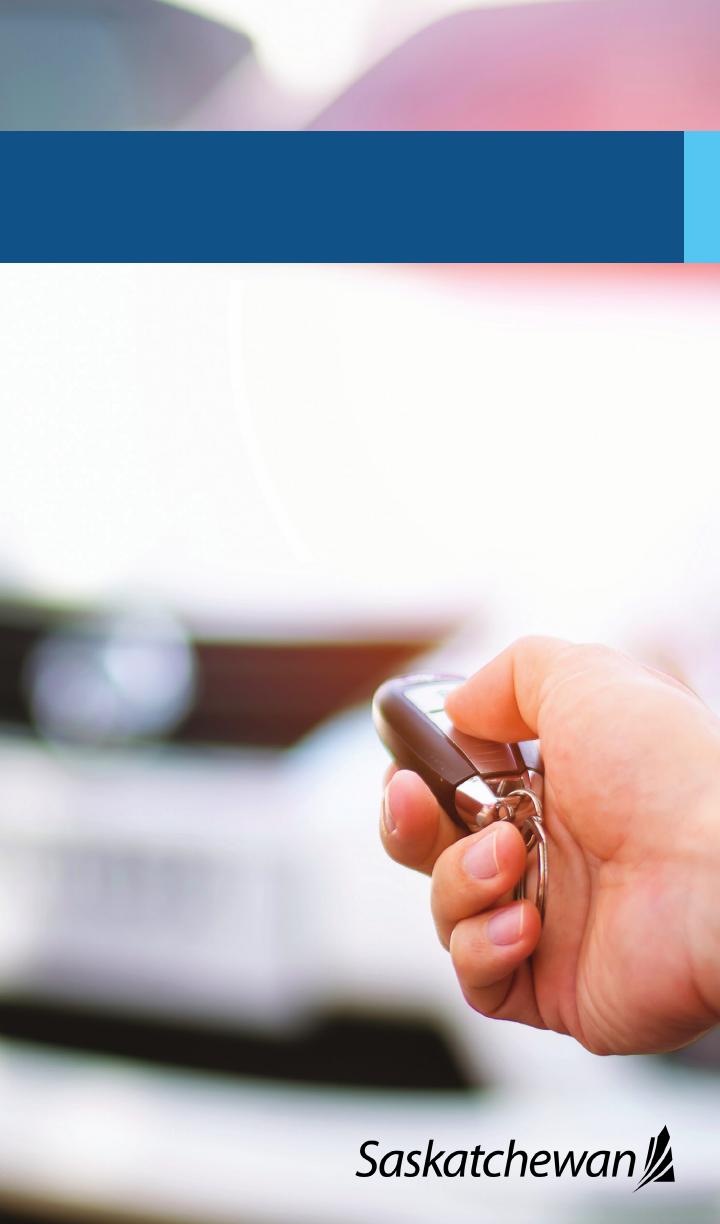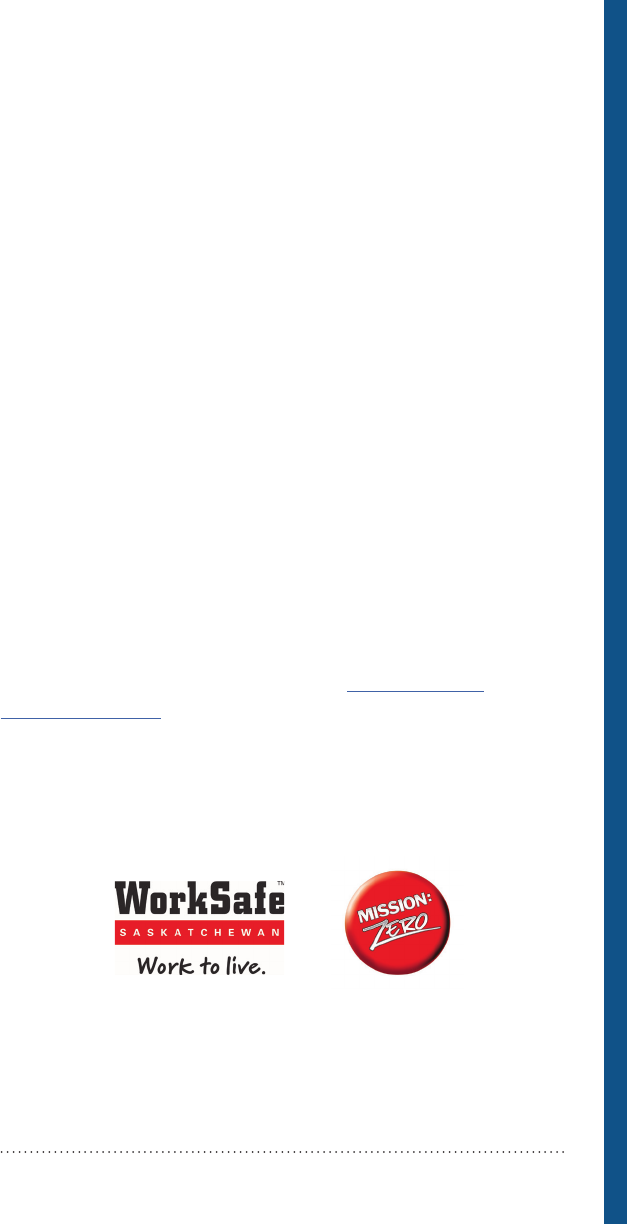
Vehicle Operator’s Handbook
How to use a Central Vehicle Agency vehicle

3
Vehicle Operator’s Handbook
Introduction and
Emergency Numbers
It’s Up to You!
Emergency events, accidents and other problems may happen when
operating your vehicle with little or no warning and can have an impact
on you and your work. We want to ensure every person driving or
riding in a Central Vehicle Agency (CVA) vehicle is safe.
Each of us has a responsibility to understand the risks associated with
operating a motor vehicle. We should also have a responsibility to learn
how to prevent or minimize those risks and to prepare ourselves for any
potential impact.
Following the procedures in this handbook will help you operate your
vehicle safely, sustainably, and cost eectively. Please get to know your
handbook thoroughly and operate your vehicle accordingly.
This guide provides advice on what to do during emergency or
non-emergency events regarding the vehicle you are driving. Keep
this guide in a visible location in the vehicle. An electronic copy
is also available on the Taskroom website at https://taskroom.
sp.saskatchewan.ca/.You can also contact your vehicle coordinator for
further information.
For further information about this guide, training, and your vehicle,
contact the Central Vehicle Agency at 1-877-787-6902.

4
Vehicle Operator’s Handbook
Emergency Contact Information
Police/Fire/EMS .................................................. 911
Health Line ....................................................... 811
Local Directory Assistance
*
....................................... 411
*Use this number to nd roadside assistance closest to you when needed.
Highway Hotline ..................................... 1-888-335-7623
RCMP (non-emergency) ................................ 306-310-7267
Saskatchewan Government Insurance (SGI)
General Inquiry: 1-844-TLK-2SGI (1-844-855-2744)
Online information: www.sgi.sk.ca/autoclaim
Accident
Reporting and Information .............................. 306-787-5085
Other Contact Information
Central Vehicle Agency (CVA) — 8 a.m. to 5 p.m.
Toll Free
*
.............................................. 1-877-787-6902
Street Address: 500 McLeod Street, Regina, SK, S4N 4Y1
General Inquiry ......................................... 306-787-6902
General Inquiry Email: cvageneralinquiry@gov.sk.ca
Vehicle Maintenance..................................... 306-787-2040
Vehicle Maintenance Email: eetserviceconsultants@gov.sk.ca
CVA Fuel Cards
Inquiries/Lost or Stolen – SaskBuilds and Procurement Financial Services
(8 a.m. to 4:30 p.m.) ...................................... 306-798-0418
Card Customer Service (after hours) . . . . . . . . . . . . . . . . . . . 1-866-571-2435
Online CVA Information: https://taskroom.sp.saskatchewan.ca/how-
do-i/manage-a-eet-vehicle/cva-eet-vehicles

5
Vehicle Operator’s Handbook
Purchasing Fuel/Fuel Card Use
CVA fuel cards are assigned to individual CVA vehicles and are only
to be used for that specic vehicle.
These are credit cards with restrictions and can only be used in
accordance with the following provisions:
• Cards are valid only for the purchase of fuel and a maximum
of $50 per day of supplies (e.g. windshield washer uid, wiper
blades, car washes, etc.).
• Most gasoline-engine vehicles require the use of regular
gasoline. Mid-grade or premium gasoline should only be used
if stipulated in the Vehicle Manufacturer’s Handbook.
• Please ensure the safety of the fuel card. Do not leave the card
loose in a vehicle exposed to public view and potential theft, or
exposed to direct sunlight (which could destroy the card).
• Some service stations require pre-payment for fuel. If the amount
of pre-payment exceeds the value of fuel, then a refund must be
issued to the credit card. Do not accept cash for overpayments.
If the receipt of cash is unavoidable, immediately notify your CVA
coordinator of the incident.
• Personal membership dividends, reward points or air miles
are not to be used with CVA fuel cards.
• Personal purchases are not permitted with a CVA fuel card (this
includes snacks, drinks, cigarettes, etc.).
• Cards are only to be used for the CVA unit of which it has been
assigned. The unit number is shown on the card.
Credit card receipts are to be maintained by the vehicle coordinator
as per the client’s usual purchasing policies.
The fuel card is not to be used to pay for repairs, towing, parking or
any personal expenses. Repairs and towing can be invoiced directly to
CVA (anything over $300 needs CVA authorization). You may need to
pay for parking and be reimbursed by your organization.
Fraudulent use of the fuel card is a criminal oence and may result
in severe penalties.

6
Vehicle Operator’s Handbook
What If…
Your fuel card isn’t working?
If the vendor is unable to process the transaction manually, you will
need to pay for the fuel yourself, keep your receipts for one year and
receive reimbursement from CVA. Reimbursement forms can be found
online at https://taskroom.sp.saskatchewan.ca/Documents/CVA-
Reimbursement-Request-Form.pdf#search=cva%20reimbursement
If the problem persists and the card is no longer working, call the eet
card administrator at 306-798-0418.
Your fuel card is lost or stolen?
Immediately call 306-798-0418 if you nd your card is lost or stolen
between the hours of 8 a.m. and 4:30 p.m., Monday to Friday. If calling
outside these hours, please leave a detailed voicemail message. In
addition, call 1-866-571-2435 to have your lost/stolen card deactivated.
Once this is done, notify your CVA vehicle coordinator of the loss as soon
as possible.
You have to travel outside of Canada?
If out-of-country travel is required, contact CVA in order to ensure
that your fuel card will work in your country of destination (such as the
United States).
CVA will inform the eet card issuer and update the security so that
your card can be used out-of-country for the time period you are on
your trip.
You have other expenses (not fuel or small vehicle supplies like
windshield washer uid)?
The fuel card is not to be used to pay for repairs, towing, parking, or
any personal expenses. Repairs and towing can be invoiced directly to
CVA. Parking may need to be paid for by yourself and reimbursed by
your organization.

7
Vehicle Operator’s Handbook
Tips for Safe and
Sustainable Operation
Pre-Trip Inspection
A quick walk around the vehicle and inspection when you start
it can make your trip a lot safer. A pre-trip inspection should be
done at regular intervals and before every trip. CVA recommends
operators complete a pre-trip inspection form before traveling, which
can be found on Taskroom at https://taskroom.sp.saskatchewan.
ca/Documents/CVA-Vehicle-Operator-Checklist.pdf. CVA Vehicle
Coordinators are encouraged to print as many copies as their program
area requires, and make them available to all CVA operators.
Check your tires frequently for correct pressure, wear and physical
damage. If you nd irregular wear, have the vehicle inspected by a
repair facility.
Driving for More Fuel Economy
Did you know that for every 10 kilometres per hour (km/h) you go
over 100 km/hr, fuel eciency drops by 10 per cent? There are many
factors you can control to optimize fuel consumption, increase the
vehicle’s life span and reduce the overall environmental impact of
your CVA vehicle:
• Don’t idle. Ten seconds of idling uses more fuel than re-starting
the engine. Turn o the engine if the vehicle is going to be
parked for more than 60 seconds.
• Winter driving warm up. Once a vehicle is running, the best
way to warm it up is to drive it. With computer-controlled, fuel-
injected engines, you need no more than 30 seconds of idling on
winter days. Ensure windows are adequately defrosted before
driving away.
• Limit your need for speed. Speeding, rapid accelerating, and
hard-braking reduce fuel eciency. Leave 20 minutes earlier to
avoid rushing and the temptation to speed.

8
Vehicle Operator’s Handbook
• Drive smoothly. Avoid quick starts and abrupt stops to help
maximize your fuel mileage. Use your cruise control on the
highway when it’s safe to keep a steady pace.
• Be tire smart. Under-inated tires can reduce the tire life by
10,000 km, and increase fuel consumption by up to ve per cent.
Check tire pressure regularly and routinely balance and rotate
your tires.
• Plan short trips. Travelling to places less than ve km away
produces the most greenhouse gas emissions because the
engine and pollution control systems never reach peak operating
temperatures. Combine various tasks into one trip to reduce
fuel emissions from 50 to 90 per cent.
• Lighten your load. Every extra 100 pounds reduces fuel eciency
by up to two per cent. Keep the trunk clean and remove any
snow and ice from the vehicle.
• Car pool. When possible during normal circumstances, car pool
with others to reduce unnecessary travel. Check this book for
inserts with current information about travelling with others or
sharing a vehicle while public health orders remain in eect.
• Fuel up, not over. Do not overll fuel. To prevent fuel spillage/
leakage, never ll the fuel tank to the brim.
• Roll ‘em up. Close windows when driving. Use the ow-through
ventilation system.
Plan Your Trip
For information regarding highway driving conditions, please check the
Highway Hotline.
Obey Trac Laws
Please follow all the rules of the road. The most common contributing
factors to collisions (per SGI) are:
• Driver inattention;
• Failing to yield the right of way;
• Driving too fast for road conditions;

9
Vehicle Operator’s Handbook
• Driving impaired;
• Disregarding a trac control device;
• Driver inexperience or confusion;
• Following too closely;
• Backing up unsafely;
• Changing lanes or passing improperly.
The maximum speed limit when passing tow trucks, service vehicles
or emergency vehicles that are stopped with their lights ashing or
when passing Ministry of Highways and Infrastructure equipment with
lights ashing, whether in motion or not, is 60 km/h.
Within the work zone (road maintenance areas), motorists are required
to slow down and travel no faster than the posted speed. Fines can
be levied for speeding when passing highway workers or equipment
occupied by a worker in the work zone.
Driving Safely
When reversing, be sure to check all mirrors and blind spots. Be aware
of any short barriers or obstacles that may not be visible over the back
of the car. Always remember that the nose of the vehicle may also
swing and hit obstacles to the side when reversing.
Check your tire pressure regularly (at least once a month), especially
after a sharp drop in temperature or before leaving on a highway trip.
The appropriate tire pressure for your vehicle can be found on the
inside back frame of the driver’s door. Under-inated tires can increase
the risk of a blowout, and increase fuel consumption by as much as ve
per cent. Over-inated tires can lead to a harsh ride, handling issues
and increased wear on tires and suspension.


11
Vehicle Operator’s Handbook
Tips for Safe and Sustainable
Operation/Unforeseen Events
Use of Electronic Devices
Cellphones are among the biggest distractions drivers face. It’s
illegal to use, hold, view or manipulate a hand-held cellphone while
driving.
• If you’re an experienced driver, meaning you’re not in the
Graduated Driver Licensing (GDL) program or Motorcycle GDL
program, you can use a hands-free device if it can be activated
with voice commands or one-touch, and is mounted on the
dashboard or visor in a cradle.
• New drivers can’t use hands-free devices at all.
Exemptions: Police, re and emergency medical services personnel
can use hand-held cellphones to perform their duties.
Vehicle Issues
Airbag Deactivation
Certain vehicles are equipped with switches that may be used to turn
o the passenger side airbag. With this switch in the “o” position, the
passenger side airbag will not deploy under any condition. To reduce
the possibility of injury to the passenger, the operator is responsible to
ensure that this switch is in the “on” position, except in exceptional
situations as noted in the Vehicle Owner’s Manual.
Vehicle Warning Lights
If an amber warning light turns on, typically you can continue your
trip and have it inspected as soon as possible.
If a red warning light turns on, stop travelling and have the vehicle
towed to a service provider. Always refer to the Vehicle Owner’s
Manual and complete the recommended action.

12
Vehicle Operator’s Handbook
Windshield Damage
It’s generally not dangerous to drive with a small crack in the
windshield, but damaged glass should be repaired or replaced as
soon as possible for two important reasons:
• Windshields weakened by damage provide less protection
• Cracked windshields decrease visibility.
Driving with a broken windshield should also be avoided whenever
the damaged glass impairs the vision of the driver. With time, moisture,
dirt and even windshield washer uid can seep into the glass sandwich
layers causing discoloration and further decreasing visibility. See
Taskroom for standing oer information.
Battery Boosting
If you are unable to start the car and your battery may be dead,
please call a roadside service provider to boost it or tow your vehicle
to a certied repair shop.
Caution: If you feel it is necessary to boost the battery yourself, be
sure to check the owner’s manual for proper boosting procedures for
your vehicle. Failure to follow the proper procedures can lead to
serious injury or death.

13
Vehicle Operator’s Handbook
Driving in Inclement Weather –
Severe Summer Weather
Environment Canada
Environment Canada monitors weather in our region and issues alerts.
For up to date information, please visit https://weather.gc.ca/warnings/
index_e.html?prov=sk.
• A weather watch indicates that conditions are favourable for
severe weather to develop in our area.
• A weather warning indicates that severe weather has developed
in the area or is imminent.
Driving in Strong Winds
High winds make steering dicult and cause vehicles to veer to the
wrong side of the road.
• Anticipate gusts. Take special care when driving through areas
prone to strong winds or when weather reports predict severe
weather.
• Notice larger vehicles. Be aware of large vehicles on the road
such as tractor-trailers and recreational vehicles. They are more
susceptible to high winds, and their drivers may have diculties
staying in their lanes.
• Keep a rm grip on the wheel. Keep both hands on the wheel in
case the wind begins to move your vehicle, especially if you are
driving a large vehicle or towing a trailer.
Driving in Heavy Rain
In addition to the potentially poor visibility that accompanies
heaviest rain, drivers should be ready to protect themselves against
hydroplaning. Hydroplaning can occur when a vehicle is traveling too
fast in heavy rain conditions, causing the vehicle’s tires to travel on a
thin layer of water rather than grip the surface of the road. This has the
potential to make steering and braking dicult and could even lead
to losing control of your vehicle.

14
Vehicle Operator’s Handbook
Follow these tips to help you stay safe while driving in heavy rain.
• Do not use Cruise Control. Refer to the owner’s manual for tips
regarding your own vehicle.
• Take your time. Slow down to help avoid hydroplaning. Also,
one of the most dangerous times to drive can be soon after it
begins to rain. The rain can cause oils on a roadway to rise to the
surface and make conditions slick. Waiting a while after rains to
begin to drive can be safer.
• Turn your lights on. This can help you to see more clearly and
helps other vehicles see you.
• Give other vehicles more space. Add 1-2 extra seconds of
following time, which gives you, and the cars behind you, more
time to react to trac.
Driving During a Hail Storm
While the average hailstorm lasts only ve minutes, the damage can
be very signicant.
• Get o the road as soon as possible. It is often better to leave
the road completely than to pull over to the side.
• Stay covered. Do not get out of your car in a hailstorm. The
pelting can cause injury to you as well as to the vehicle, so it is
safer to stay inside the car until the storm passes.
• If the vehicle sustains hail damage, ll out a CVA Vehicle
Accident Report, found at https://taskroom.sp.saskatchewan.
ca/Documents/Central-Vehicle-Agency-Accident-Report.
pdf#search=vehicle%20accident, and submit to your supervisor.
Driving When a Tornado Approaches
Many people think of a tornado as simply a churning column of high
wind. They do not consider the erratic nature of the tornado, with
its tendency to rapidly change direction. Another dangerous aspect
of a tornado is the debris that it carries along with it, making this a
projectile-carrying storm that you should take steps to avoid.
If a tornado approaches when you are on the road, try to get to an
indoor shelter as quickly as possible. Find a sturdy building and get

15
Vehicle Operator’s Handbook
to the basement or an interior room. If you cannot reach shelter:
• Get o the road as soon as possible. It is often better to leave
the road completely than to pull over to the side.
• Avoid stopping under bridges and tunnels. These over and
under passes channel high winds, making them more dangerous
than being out in the open.
• Stay low. Stay in your car, secured into your seat belt, and put
your head down below the window — covering it with your
hands or a blanket if you have one. Or, if you can safely get lower
than the level of the roadway (i.e. a ditch), exit your car and lie in
that area, covering your head with your hands.
Driving in Fog
Fog can be one of the most dangerous weather conditions for both
new and experienced drivers. Fog has the potential to reduce visibility
signicantly, so it is critical that drivers stay focused on the road in
order to stay safe.
• Slow down so you have more time to react if trac stops or other
hazards appear. When visibility is severely limited, nd a safe
place to park, and wait for conditions to improve.
• Always headlights, never brights. Fog consists of tiny water
droplets that spread and reect light. While your high beams
are not useful in the fog, remember to turn on your low-beam
headlights to help other drivers see you.
• Stay focused on the road. Driving in fog is not a time for multi-
tasking. Turn down the radio, stop conversations with other
passengers and keep your attention on the road. Roll down
your window to help you hear other trac on the road.
Animals on the Road
Wild animals are unpredictable but there are times when the risk of
a collision is particularly high. Be alert during the months of May and
June when animals are drawn to ditches for road salt and to escape
biting insects. Animals are also especially active in the late fall and
early winter during mating season and migration. The peak times
for collisions are dawn and dusk.


17
Vehicle Operator’s Handbook
Driving in Inclement Weather –
Severe Winter Weather
Plan Your Trip
In Saskatchewan, it is possible that you could be operating your vehicle
for at least ve months of the year in winter driving conditions. It is in
this period, from November to March, that most collisions occur.
Snow, ice and freezing rain reduce traction. Drifting and blowing snow,
fog, whiteouts, gas exhaust clouds and frosted windows may severely
limit visibility. The main cause of collisions in winter months is failing to
adjust to the changing conditions.
For information regarding highway driving conditions, please check
the Highway Hotline.
Environment Canada
Environment Canada monitors weather in our region and issues alerts
at https://weather.gc.ca/warnings/index_e.html?prov=sk.
• A weather watch indicates that conditions are favourable for
severe weather to develop in our area.
• A weather warning indicates that severe weather has developed
in the area or is imminent.
Prepare Your Vehicle
Winter conditions, plus the eects of extremely low temperatures,
demand that a vehicle be in top condition. For this reason, ensure the
semi-annual inspection, routine and preventative maintenance is up to
date. In the end it is less annoying and less costly than battery boosts,
tows and being late. Give special attention to your heater and defroster.
Consider having these items in the vehicle:
• Snow brush and scraper (supplied by CVA;
• Snow shovel;

18
Vehicle Operator’s Handbook
• Safety kit;
• Blanket;
• Booster cables;
• Candle and matches;
• Block heater extension cord (supplied by CVA);
• Spare windshield washer uid.
Make sure you have changed the vehicle’s tires to winter tires
*
.
*CVA will pay for winter tires if required by the client. The user agency will
be responsible for the storage and tracking of the extra set of tires between
seasons as well as any cost associated with storage. See the Winter Tire
section in Maintenance/CVA Semi-Annual Inspections.
Make it a practice to keep your gas tank full so you can run your engine
and stay warm if you get stuck or stranded.
Preparing to See and to Be Seen
If you cannot see through your windows, you should not drive. Also,
your lights and signals exist to protect you, and must be visible to
others. Before you drive, do the following:
• Brush the snow o your car.
• Scrape the windshield, rear and side windows.
• Clear your heater air intake (usually in front of the windshield).
• Clean your headlights, tail lights and signal lights.
• Drive with your headlights on at all times. Even on a clear day,
swirling snow makes it dicult to see and to be seen.
Driving on Slippery Surfaces
Winter traction problems require a number of changes from summer
driving techniques. The general rule for driving on slippery conditions
is to drive slowly.
• You should not use cruise control on icy or slippery roads. This
is even more important when the road may have black ice formed
on it (a thin layer of transparent ice).

19
Vehicle Operator’s Handbook
• Traction varies tremendously with temperature changes. For
example, icy roads will look just the same at -2°C or -22°C, but will
be far more slippery at the warmer temperature. Winter driving
calls for special driving skills. This means gentle acceleration,
gentle braking and small, smooth steering movements.
Driving in a Blizzard
• Stay home. Only go out if necessary. Even if you can drive well
in bad weather, it’s better to avoid taking unnecessary risks by
venturing out.
• Drive slowly. Always adjust your speed down to account for lower
traction when driving on snow or ice.
• Accelerate and decelerate slowly. Apply the gas slowly to regain
traction and avoid skids. Don’t try to get moving in a hurry. Take
time to slow down for a stoplight. Remember that it takes longer
to slow down on icy roads.
• Increase your following distance to ve to six seconds. This
increased margin of safety will provide the longer distance
needed if you have to stop.
• Know your brakes. Whether you have antilock brakes or not,
keep the heel of your foot on the oor and use the ball of your
foot to apply rm, steady pressure on the brake pedal.
• Don’t stop if you can avoid it. There’s a big dierence in the
amount of power or force it takes to start moving from a full
stop versus how much it takes to get moving while still rolling.
If you can slow down enough to keep rolling until a trac light
changes, do it.
• Don’t power up hills. Applying extra gas on snow-covered roads
will just make your wheels spin. Try to get a little inertia going
before you reach the hill and let that inertia carry you to the top.
As you reach the crest of the hill, reduce your speed and proceed
downhill slowly.
• Don’t stop going up a hill. It’s a challenge to get moving up a hill
on an icy road. Get some inertia going on a at roadway before you
take on the hill.

20
Vehicle Operator’s Handbook
Stuck in the Snow
Refer to the vehicle owner’s manual for the proper procedure when
stuck in snow. In all cases, the safest way to resolve the situation is to
call a tow service. Please refer to “Road Assistance/Service” on page 33
of this handbook for tow service contact information.
Rocking your vehicle: If you think you can get out, place your vehicle in
drive, and gently accelerate. When your wheels spin, immediately stop
accelerating and hold the vehicle with the brake to stop it from rolling
back. Shift into reverse, release the brake and accelerate gently. When
the wheels spin again, stop. Repeat this forward-backward rocking
movement, until you gain sucient momentum to move ahead.
Search for traction. Look for sand or grit. Choose snow rather than ice.
A small movement to one side will often move you from a low traction
icy patch onto snow or sand.
Further Help if Stuck in the Snow and Unable
to Get Out
If you are unable to get out of deep snow or are in a drift/ditch, you
should call a roadside service provider.
If you are stranded:
• Always stay with your vehicle.
• Keep calm.
• Lower your downwind-side windows slightly and open the heater
air vent to get air into the vehicle.
• Run the engine to get some heat, and to listen to news reports,
but do not run out of gas.
• Keep your exhaust pipe clear of ice and snow.
• Get into your emergency clothing before you get cold.
• If necessary, use candles to keep warm. Be careful not to overexert
yourself by shovelling or by pushing your vehicle.
Many people die when they leave their vehicles to walk for help in
a blizzard. If you stay with your vehicle, you have a better chance of
surviving and are more likely to be found.

21
Vehicle Operator’s Handbook
Maintenance/CVA Semi-annual
Inspections
Maintenance and Repairs
Maintenance and repairs are important to ensuring safe operation and
longevity of a vehicle. A number of processes and agreements are in
place to make sure the operator has access to timely vehicle
maintenance and repairs.
You are responsible to ensure that routine and preventative
maintenance, recalls and semi-annual safety inspections are performed
on the vehicle in a timely manner.
When to Do Your Maintenance
It is always a good idea to do your semi-annual inspection and
maintenance so that it coincides with pre-winter preparation and again
in spring for summer. This also can coincide with changing winter tires
to regular tires and back. Routine maintenance is done as needed or
specied by km interval.
Routine Maintenance
Washing and Cleaning
You are required to maintain your vehicle in a presentable condition.
Weather conditions in your area will determine the frequency of
washing. Obtain authorization from CVA at 1-877-787-6902 prior to
having your vehicle detailed.
Oil Change and Service
Service Interval Additional Information
Change oil
and lter
Every 6,000 kilometres or six
months, whichever is rst.
Also check lights, horn, wipers,
battery terminals, uid levels,
belts, hoses and tire pressure
(including spare).
Rotate Tires Every second oil change.
Replace
diesel fuel
lters
At the manufacturer’s required
interval.
For diesel vehicles only. Use
OEM (Original Equipment
Manufacturer) parts.

22
Vehicle Operator’s Handbook
Semi-Annual Inspections/Winter Preparation /
Summer Preparation
CVA is dedicated to the safety of our eet and the clients we serve.
As part of our safety program we require all vehicles to go through a
semi-annual safety inspection.
All vehicles must be taken to a vehicle repair shop twice a year to have
a semi-annual safety inspection completed. Semi-annual inspections
and maintenance should be done so that they coincide with pre-winter
preparation and again in spring for summer. It should be done every
six months regardless of distance travelled.
• The Semi-annual Inspection Form is used for inspections required
by CVA. Please note that Highway Trac Board inspections are
required for certain classes of vehicles. Your system-generated
reminder will identify this requirement. The inspection form can
be found at https://taskroom.sp.saskatchewan.ca/Documents/
Central-Vehicle-Agency-Semi-Annual-Safety%20Inspection.pdf
• The inspection should include a complete visual inspection
and Highway Road Test, which covers all major systems including
brakes, steering, suspension, and safety items (e.g. operation of
all seat belts) as well as raising and lowering the spare tire winch
(if equipped).
Required repairs must be estimated and the repair authorization
process followed.
Recalls
Have your vehicle identication number (VIN), also referred to as a
serial number, checked by the dealer at least semi-annually for
outstanding recalls or updates.
Contact CVA at 1-877-787-6902 for maintenance, transmission,
dierential and coolant service intervals, and other maintenance
specic to your vehicle.

23
Vehicle Operator’s Handbook
Winter Preparation
Anti-Freeze
The anti-freeze must be checked each fall to ensure it is up to strength
and will resist minus-forty-degree (-40°C) temperatures. Your vehicle is
equipped in production with lifetime anti-freeze. Never ll the cooling
system with water. Consult your owner’s manual for appropriate
maintenance guidelines.
Winter Tires
Winter tires’ deep treads are ideal for clearing snow, giving maximum
traction and control. More than half of Canadian drivers see a benet in
installing winter/snow tires. There are fewer winter-related accidents,
injuries, and deaths when cars are tted with winter/snow tires.
CVA will pay for winter tires if required by the client. The user agency
will be responsible for the storage and tracking of the extra set of tires
between seasons as well as any cost associated with storage (the CVA
Tire Standing Oer has the option for client-paid tire storage). CVA will
pay for the reasonable cost of changing tires between seasons (no tire
studs).
Summer Preparation
After six months of winter, it’s time to prepare for summer and have
your semi-annual inspection. Remember with warmer weather you
may need to check your tire pressure and coolant levels.
Also it’s time to change your winter tires back to all-season as winter
tires wear faster on warm pavement.
Notications
CVA will notify you when a safety recall is to be done on a vehicle.
Note that even though CVA does their best to communicate all types
of recalls (Safety, Emissions, and Customer Satisfaction recalls) to
clients, it is a good idea to check with a dealership for any outstanding
recall the vehicle may have.
CVA will also notify you if your semi-annual inspection is not done as
required.

24
Vehicle Operator’s Handbook
No Smoking
Government’s policy is that all government vehicles are smoke
free. It is the responsibility of the user agencies and other prescribed
government institutions to enforce this policy in their vehicles. When
the vehicle is returned, CVA will charge back any incurred expenses to
clean and eliminate smoking or vaping residue and odour present in
the CVA vehicle if required.

25
Vehicle Operator’s Handbook
Purchases/Administrative
Requirements
Repairs and Authorization
If your vehicle requires repair, have an accredited repair vendor provide
a repair estimate. The vehicle operator can authorize up to $300 for
minor repairs, diagnosis of concerns and routine maintenance.
If the repair estimate totals $300 or more including parts, labour, shop
supplies and PST, repair authorization must be obtained from CVA by
calling 1-877-787-6902 or emailing eetserviceconsultants@gov.sk.ca
before the repairs are started.
Prior authorization is also required before repairs are made for the
following, even if estimated at under $300:
• Coolant ushes;
• Transmission ushes;
• Transfer case or dierential uid changes;
• Windshield replacement;
• Battery replacement;
• Tires.
Warranty service and recalls are only available from authorized dealers.
Work Orders: Fully describe the nature of the required vehicle services/
repairs on the vendor work order. This information is essential when
processing service/repair orders for payment. The vehicle operator is
responsible for reviewing the completed work order to ensure that
the charges relate only to repairs/work requested.
After reviewing the work order, if satisfactory, sign the “out” portion
certifying that the work has been performed. The vehicle operator is
responsible for properly instructing the repair vendor on the correct
authorization process. CVA prefers to receive all estimates, accident
forms and SGI Appraisals by email at eetserviceconsultants@gov.
sk.ca

26
Vehicle Operator’s Handbook
Invoices and Work Orders
A work order or invoice must show the following information:
• Odometer reading, unit number and license plate number;
• Charge to: Central Vehicle Agency, 500 McLeod Street, Regina,
SK, S4N 4Y1;
• User agency name (i.e. Highways, SGI, etc.);
• Full description of the work performed including itemized parts,
part numbers and labour costs;
• Printed name and signature. Direct the vendor to send the
original customer copy to CVA;
• If you are having a semi-annual inspection completed, the driver
must sign the inspection sheet.
Repairs must be detailed on a vendor work order/invoice. These work
orders/invoices must be charged to CVA and the signed original copy
forwarded by the vendor to CVA for payment.
Tires
CVA establishes standing oers with the major tire manufacturers
and arranges for tires to be supplied at various tire dealers throughout
the province. See the current preferred vendors at https://taskroom.
sp.saskatchewan.ca/Documents/CVA-Tire-Vendor-List.pdf
All requests for tires require prior authorization from CVA by calling
1-877-787-6902. Tire purchases must be detailed on a work order/
invoice, which must be charged to CVA.
Parking and Storage
CVA is not responsible for the parking and storage of its vehicles.
Storage and parking arrangements should be referred to your agency
head oce. Payment of parking tickets is the responsibility of the driver
involved.

27
Vehicle Operator’s Handbook
Personal Use of CVA Vehicles
Personal use of CVA vehicles is strictly prohibited unless the use is
approved. Please refer to your vehicle coordinator or use Taskroom for
more information on personal use of CVA vehicles. https://taskroom.
sp.saskatchewan.ca/Documents/CVA-Guidelines-for-Personal-Use.pdf
Tickets and Violations
CVA is not responsible for paying parking or trac tickets or violations.
It is the responsibility of the driver to deal with any tickets in a timely
manner. You must notify CVA if any other action is going to be taken
apart from paying the ticket. CVA may assess a handling charge for
correspondence relating to unpaid parking tickets.
Insurance
Coverage
CVA vehicles have the mandatory licence plate insurance provided
to all vehicles registered in Saskatchewan. The licence plate insurance
provides liability insurance and covers the cost of damages caused by
the driver in a motor vehicle collision. SaskBuilds and Procurement also
carries additional liability insurance for all CVA vehicles.
Vehicle Registration
CVA will arrange for all licensing transactions (renewals, plate
replacements, etc.).
Vehicle Operator Responsibilities
Once a year you will receive the renewed vehicle registration from CVA.
If you have not received your renewed registration, please call CVA at
1-877-787-6902. For SGI insurance coverage to be valid, the following
numbers on the vehicle registration must be identical to those on the
vehicle itself:
• VIN/serial number;
• Unit number;
• Licence number.

28
Vehicle Operator’s Handbook
If any errors are found on the registration card, please contact CVA
immediately.
The operator of the vehicle is the only person able to ensure that the
vehicle has valid plates; therefore, any tickets incurred because of
invalid or missing plates will be the responsibility of the operator. As
the operator of the vehicle, it is your responsibility to ensure that you
are driving a legal vehicle.
National Safety Code (NSC) in Saskatchewan
To ensure compliant operation of the vehicle check that you are
following the National Safety Code (NSC). To avoid the illegal operation
of vehicles, ensure that the NSC and local legal requirements for driver’s
licence classication, logbooks, over-weight licence fees and trailer
towing are followed.
Do not drive your vehicle outside of Saskatchewan if it has a
Gross Vehicle Weight Rating (GVWR) of 5,000 Kilograms or
more. Vehicles over a GVWR of 11,793 Kilograms must adhere to
the Saskatchewan National Safety Code (NSC) guidelines. If you are
unsure about your vehicles status under NSC rules please ask CVA by
contacting 1-877-787-6902 or look at Taskroom for more information.
Distance Reporting
Accurate reporting of distance is essential. The information is
required for eet management purposes. Vehicle Distance Reports
are to be completed and submitted to your vehicle coordinator
once each month, by the 10th day of the following month. Contact
your vehicle coordinator for your organization’s distance reporting
procedure.

29
Vehicle Operator’s Handbook
Collisions/Accidents
Accidents – What to Do After an Accident
Safety First!
Take whatever steps necessary to protect yourself from further injury.
Do not move an injured person unless it is necessary to get the person
out of danger of further injury. Only provide the rst aid that you are
qualied to provide.
1. Collect Information
Unless this was a single-vehicle collision, get information from the
other driver and any witnesses. Take pictures of the collision damage
on all vehicles involved, if it is safe to do so.
2. Inform the Police
You must report the collision to the police immediately if any of the
following criteria apply:
• There was any bodily injury or death;
• One of the drivers appeared to be under the inuence of drugs
or alcohol;
• One or more vehicles aren’t roadworthy and had to be towed
from the scene;
• The collision involved a vehicle without a valid licence plate;
• One or more of the vehicles had an out-of-province plate;
• There was loss or damage to your vehicle caused by theft or
attempted theft; or
• You can identify who caused a random act of vandalism or
intentional malicious damage.
Hit and Run Collisions
You only need to report a hit and run collision to police if you know
when and where the damage occurred and there is physical evidence
or witnesses that can verify the damage was caused by another vehicle.

30
Vehicle Operator’s Handbook
If you’re not sure whether or not to report a hit and run, wait until you
get your damage estimate and your SGI adjuster can advise you if it
should be reported to the police.
No Need to Report to Police
You don’t need to report damage to the police if it’s from a:
• Door ding or a shopping cart in a parking lot; or
• Random act of vandalism or intentional malicious damage and
you can’t identify who caused it.
Notes:
• Cooperate with local law enforcement. Provide factual
information. Limit responses to questions asked.
• Obtain the driver’s name, address, phone number, licence and
plate number, and the name and address of the owner if the
driver is not the owner. Identify witnesses and obtain addresses
and phone numbers.
• Do not discuss your actions with parties other than law
enforcement. Do not admit fault to other parties or make any
statements about the province’s response to the accident,
nancial or otherwise.
3. Report to SGI
Report your claim online with Auto eClaim (www.sgi.sk.ca/eclaim), visit
a local claims centre or call SGI toll free.
SGI Toll Free Business Hours Number:
1-800-667-9779
Monday to Friday: 8 a.m. to 5 p.m. CST
Saturday: 9 a.m. to 5 p.m. CST
SGI After regular business hours:
1-800-647-6448

31
Vehicle Operator’s Handbook
What You’ll Need
Have the following ready when reporting your claim:
• Your driver’s licence;
• Your vehicle registration;
• All the information you collected from the collision at the scene;
• Your auto extension insurance company and policy number – if
available.
SGI will assign a claims adjuster to manage your claim.
Note: If your vehicle isn’t safe to drive, and the police haven’t already towed
it, talk to your adjuster to nd out where it needs to be towed.
4. Report to CVA and Your Supervisor
Report the accident to your supervisor and to the CVA accident
desk (1-306-787-5085) as soon as possible. An Accident Report Form
must be lled out for every case of vehicle damage, regardless of the
amount of damage. The Accident Report Form may be found online
at https://taskroom.sp.saskatchewan.ca/Documents/Central-Vehicle-
Agency-Accident-Report.pdf
Body or undercarriage damage resulting from material handling or
continuous contact with road obstructions will not be considered an
accident.
5. Get a Damage Estimate
After ling your claim, SGI needs to appraise your vehicle to nd out
how bad the damage is and prepare a damage estimate. The damage
estimate can be completed at either an accredited repair shop (if
eligible) or a SGI claims centre.
If the vehicle is not drivable, have the vehicle towed from the scene
to the nearest SGI compound. Once the damage estimate is done,
you’ll get a printout with the cost of repairs for your vehicle. The claims
adjuster will need to conrm your insurance coverage before you can
have the vehicle xed.
Forward the Accident Report Form and SGI Estimate through your
supervisor to CVA.

32
Vehicle Operator’s Handbook
6. Have your Vehicle Repaired
Indicate on the Vehicle Accident Report if repairs need to be performed
immediately.
Obtain and submit the damage estimate to your supervisor who will
obtain authorization from CVA to have the vehicle repaired at any SGI
accredited body shop. Do not proceed with repairs until you receive
authorization from CVA.
7. Authorize Payment
On completion of repairs, as the vehicle operator, you will act as
the duly authorized agent of CVA with signing authority to release
the vehicle in accordance with the conditions contained in the SGI
Certication of Repairs Form.

33
Vehicle Operator’s Handbook
Roadside Assistance/Service
Road Service
Warranty
Some vehicles may have their New Vehicle Warranty which comes with
Roadside Assistance (information can be found in the Owner’s Manual).
Please check to see if your vehicle is still under this warranty.
Warranty Roadside Assistance provides several emergency services
such as boosting, towing, spare tire installation, gas delivery, winch
service and lockout service free of charge. The toll-free phone numbers
for the individual manufacturers are as follows:
General Motors (GM) .................................. 1-800-268-6800
Ford ................................................... 1-800-665-2006
Chrysler/Jeep .......................................... 1-800-363-4869
Toyota ................................................. 1-888-869-6828
Mitsubishi ............................................. 1-888-576-4878
Mercedes Benz (Smart) ................................ 1-877-387-0100
Nissan ................................................. 1-800-267-5936
Honda ................................................. 1-800-465-7587
Hyundai ............................................... 1-888-268-9958
Non-Warranty
If the vehicle’s Roadside Assistance has expired, call 411 to obtain
information on the nearest tow operator to your location. It is
imperative to know your location on a particular route should you
require assistance.
Tire Hazard Not Included
Vehicle warranty does not apply to tires. Tire manufacturers, through
their respective dealers, will provide all tire adjustments.

34
Vehicle Operator’s Handbook
Towing Payments and Lock-out Service
The driver should request the tow operator to charge CVA directly
(most Saskatchewan towing companies will know how to do this upon
request). Some tow operators may require immediate payment for
towing services; therefore, the driver may be required to pay, and then
be reimbursed for their expense.
If a tow is not related to a mechanical issue CVA will charge back the
costs to the user agency.
If lockout service is needed as a result of driver error or negligence,
the costs will be charged back to the client organization.

